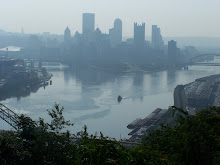Mon., July 28
John Howland from Rutgers University was scheduled to talk to us about the Harlem Renaissance. Unfortunately, his flight got cancelled then delayed then something else and he was not able to make it to Pittsburgh. We got a version of his lecture which was amazingly still pretty informative.
Howland made a distinction between the Harlem Renaissance (or New Negro Movement) and the popular music like jazz during that period. Whereas the New Negro Movement tried to create music/art that was high art and “dignified”, the modern jazz culture was regarded as decadent, lower-class, corrupting, evil, and associated with the rural, uneducated. Artists that were part of the Harlem Renaissance included Paul Johnson, Bessie Smith with “Moan you Moaners”, Paul Robeson with “Ol’ Man River”, and James Weldon Johnson with “Lift Every Voice”, the song that came to be regarded as the Negro National Anthem. Duke Ellington with his 1930’s hit “Don’t Mean a Thing” was considered high art even though it was jazz.
On Christmas Eve 1905, there was an incident in Harlem—not yet an African-American community at that time—and it served as an impetus for landlords to throw out the lower-class white immigrants in favor of African-Americans who were willing to pay more. The Great Migration of Southern blacks into places like Harlem infused the existing music with a Southern African-American rural style. The charleston, in fact, was an example of a dance style that was first seen in South Carolina and introduced up North.
In 1935, three men were killed in Harlem in the Harlem Race Riots and for many scholars this was the end of the Harlem Renaissance. During the 1920’s the black population in Harlem had exploded 115 % to 327,000 by the end of the decade, and it was during this time that Harlem became a ghetto. There were more race riots in 1943, and Harlem hit rock bottom in the 1970’s and 80’s.
The Cotton Club kept coming up in our questions though it didn’t seem to be a major part of his lecture. Jan and Mark pointed out that blacks were allowed into clubs such as the Cotton Club only as performers. Even Josephine Baker, a very prominent and rich performer, was not allowed into the Cotton Club. This may have been part of the reason she moved to Paris.
Other artists of the Harlem Renaissance included Best Williams (“Nobody”), James Reese Europe and the Clef Club, Mamie Smith (“Crazy Blues”), Thomas “Fats” Waller (“Ain’t Misbehavin’”), and of course Louis Armstrong.
That afternoon, we did a close reading of "Strange Fruit". I had never really sat down and read through or listened to the lyrics before so did not realize that's what that song was about! The song would be a great one for the English classroom with its devastating metaphor and powerful message.
Tuesday, July 29, 2008
Subscribe to:
Post Comments (Atom)

























No comments:
Post a Comment